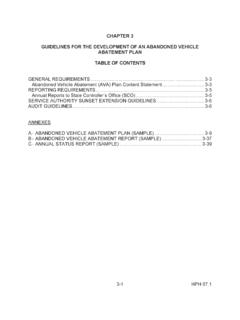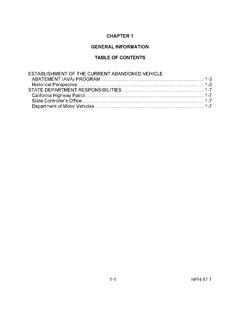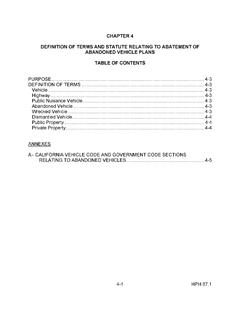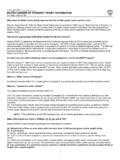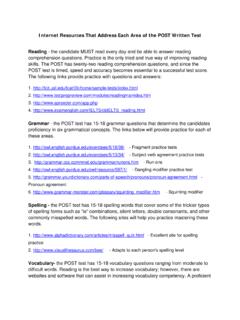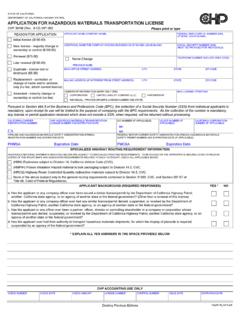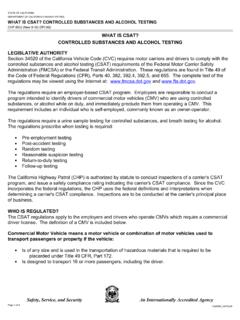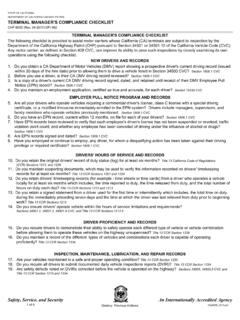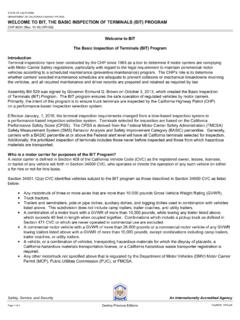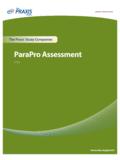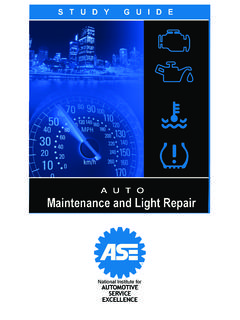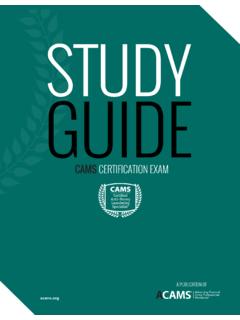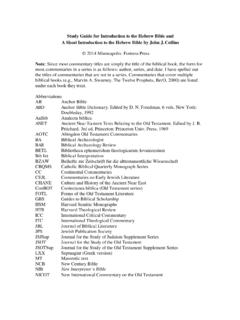Transcription of Applicant Study Guide - California Highway Patrol
1 Applicant Study Guide (916) 843-3275 Revised May 2014 FOREWORD Revised May 2014 The Applicant Study Guide provides an overview of the California Highway Patrol (CHP) and is designed to prepare Cadet, CHP, applicants for the selection and hiring process. Information contained in this Guide focuses on the Department s mission, purpose, and objectives as well as the duties of the CHP officer. This Guide will assist the Applicant in understanding the overall responsibility of becoming a CHP officer. The Applicant Study Guide is an excellent resource for applicants preparing for the Physical Ability Test, Written Examination, Psychological Evaluation, Background Investigation, Academy Training and a career with the CHP. The success of each Applicant is very important to the CHP. Therefore, we strongly encourage each Applicant to thoroughly review the Applicant Study Guide . Questions may be referred to Recruitment Program staff at (916) 843-3275 or to electronic mail at i Applicant Study Guide TABLE OF CONTENTS Revised May 2014 Page CHAPTER 1 - California Highway Patrol GENERAL INFORMATION.
2 1-1 HISTORY OF THE CHP .. 1-2 CHP GEOGRAPHICAL JURISDICTION/ORGANIZATION .. 1-2 FULL PEACE OFFICER 1-3 THE CHP ACADEMY OVERVIEW .. 1-4 CHAPTER 2 SELECTION PROCESS - PHYSICAL ABILITY TEST (PAT) MINIMUM REQUIREMENTS FOR ELIGIBILITY FOR THE EXAMINATION .. 2-1 PHYSICAL ABILITY TEST (PAT) .. 2-2 CHAPTER 3 WRITTEN EXAMINATION WRITTEN EXAMINATION PREPARATION .. 3-1 CHAPTER 4 - BACKGROUND INVESTIGATION, MEDICAL EVALUATION, PSYCHOLOGICAL EVALUATION, ACADEMY INVITATION BACKGROUND INVESTIGATION .. 4-1 MEDICAL EVALUATION .. 4-2 PSYCHOLOGICAL INTERVIEW/ PSYCHOLOGICAL WRITTEN TEST .. 4-2 ACADEMY INVITATION .. 4-2 CHAPTER 5 - LIFE AT THE ACADEMY REPORTING TO THE ACADEMY .. 5-1 ACADEMY LIFESTYLE .. 5-3 ACADEMY TRAINING .. 5-4 CHAPTER 6 - CADET FIELD ASSIGNMENT PROTOCOL ASSIGNMENT/GRADUATION .. 6-1 FIELD TRAINING AND PROBATION .. 6-1 Applicant Study Guide ii 1-1 Applicant Study Guide CHAPTER 1 California Highway Patrol Revised May 2014 1.
3 GENERAL INFORMATION. a. Mission (and goals revised July 2015). The mission of the California Highway Patrol (CHP) is to provide the highest level of safety, service, and security to the people of California . This is accomplished through five (5) departmental goals: Protect life and property. We make California a great place to live, work, and travel by reducing fatalities, injuries, and crime. Provide superior service to the public and assistance to allied agencies. We are committed to providing first class customer service. Enhance public trust through community outreach and partnerships. We model the Department s Professional and Organizational Values in every interaction. Invest in our people. We develop and support our workforce to sustain a world-class organization. Identify and respond to evolving law enforcement needs. We demonstrate leadership by addressing merging trends. b. Organizational Values. To accomplish our mission, we are committed to the following organizational values as the foundation of our pledge to public safety and service: Respect for others.
4 Fairness. Ethical practices. Equitable treatment for all. c. Rank Structure. Commissioner, Deputy Commissioner, Assistant Commissioner, Chief, Assistant Chief, Captain, Lieutenant, Sergeant, Officer. 2. HISTORY OF THE CHP. In 1896, the first automobile appeared in California . From this day forward, California 's interest in the automobile had begun. With the increase in automobiles throughout the state, particularly in populated cities and counties, traffic accidents also increased. The Applicant Study Guide 1-2 first automobile-related fatality was recorded in 1902. The need for traffic control services became apparent. Cities and counties began by regulating motor vehicle operations within their own jurisdictions. As each jurisdiction passed its own regulations, the differences from one area to another created a new set of problems. As such, in 1905, the California Legislature responded by providing the first in a series of laws related to traffic regulation.
5 As the need for uniform motor vehicle regulations continued to grow, the " California Vehicle Act of 1915" was enacted, a forerunner of today's California Vehicle Code. By 1923, the Legislature authorized the appointment of State Inspectors and Traffic Officers. They were paid and employed by the state to enforce motor vehicle laws. These appointees were assigned to work in a specific county under a system known as "Dual Control." The problem with "Dual Control" was that the Traffic Officers were controlled by the counties. California still lacked statewide uniformity in the enforcement of traffic laws. Therefore, on August 14, 1929, the Legislature created the California Highway Patrol . This new agency had statewide authority to enforce traffic laws on county and state highways responsibilities that are, to this day, still a primary component of the Department s mission. Over the years, the CHP has continued to grow and change, assuming many more responsibilities along the way.
6 Today, the organization includes a diverse group of men and women who ensure the responsibilities of the Department are carried out in the most professional and efficient manner. 3. CHP GEOGRAPHICAL JURISDICTION/ORGANIZATION. Since California is comprised of 158,693 square miles from Oregon to the Mexico Border, the terrain, weather conditions, and roadways are extremely diverse. The CHP patrols all state freeways in the 58 counties, including those within city boundaries. These freeways include routes, interstate highways, and California state routes. The Department has traffic jurisdiction on all public streets and highways in unincorporated areas under state and county control. In all, more than 105,000 miles of roadway fall within the CHP's jurisdiction. The CHP is divided into eight geographical Divisions covering the entire State of California . Personnel ranking from officer to chief, with the support of civilian personnel, staff each Division.
7 These ranking officials command, manage, and support operations in Area offices, communication centers, and commercial vehicle inspection/scale facilities throughout their geographical jurisdiction. Together these posts provide services which ensure public safety and security, as well as to ensure lawful and efficient use of the Highway transportation system. To oversee the CHP Divisions, CHP Headquarters in Sacramento provides general support to the various CHP programs, disseminates policy and procedure, and provides training to run these programs. 1-3 Applicant Study Guide 4. FULL PEACE OFFICER POWER. Authorities. Section of the California Penal Code identifies the uniformed employees of the CHP as peace officers whose authority extends statewide. According to the Penal Code, their primary duty is the enforcement of any law relating to the use or operation of vehicles upon the highways, or laws pertaining to the provision of police services for the protection of state officers, state properties, and the occupants of state properties, or both, as set forth in the Vehicle Code and Government Code.
8 Division 2 of the California Vehicle Code further defines CHP function and powers, including authorities for accident investigations, CHP issued licenses, and emergency vehicle permits. The Department s primary purpose is to ensure public safety and provide responsive services to the residents of California . The Department s mission is met through the management of traffic on California s highways, roadways, and assigned surface streets. Traffic management consists of various responsibilities that include accident prevention, emergency traffic and/or incident management, law enforcement duties, and assistance to allied agencies and the public. Additionally, the CHP has the responsibility for investigation of all crimes that occur on state property, and protection of state buildings, and justices of the California Supreme Court and Appellate Court. The following is a list of some of the diverse positions necessary to accomplish and maintain these services: Motorcycle Officer Recruiting Officer Commercial Vehicle Enforcement Officer Weapons Training Officer Evidence Officer Advanced Accident Investigation Officer Field Training Officer Canine Officer Public Information Officer Air Operations Pilot/Observer Drug Recognition Expert Court Officer Multi-disciplinary Accident Investigation Team Background Investigator Auto Theft Investigator Training Coordinator Dignitary Protection Academy Instructor Staff Officer Safety Services Program Officer Equestrian Patrol Bicycle Patrol Capitol Protective Services Court Services Community Services Officer 5.
9 THE CHP ACADEMY OVERVIEW. a. The CHP Academy is one of the most modern and professional law enforcement training facilities in the world. The Academy, covering 456 acres, is located in West Sacramento, California , and has been in use since September 17, 1974. The dormitory style housing facilities can accommodate approximately 480 Applicant Study Guide 1-4 personnel. The primary mission of the Academy is to prepare cadets for the tasks they will be required to perform in the field so they may carry out the purpose, objectives, and goals of the Department. The secondary mission of the Academy is to provide specialized in-service training for CHP personnel and allied agency employees. b. The Dining Facility can accommodate up to 400 personnel. The food is served cafeteria style three times daily. The dining facility staff is able to prepare a wide variety of specialty foods as needed. c. The Multi-Purpose Room serves as a gymnasium and an auditorium.
10 It consists of a full length basketball court, two weight training rooms (free weights and machine weights), and locker rooms. Additional physical training facilities consist of a professional running track with a grass infield, a 442-foot obstacle course, and several running trails. d. The Recreation Room has computers, a Post Exchange store, pool tables, and a big screen television. This is also the location of the Staff Office which is staffed by an officer 24 hours per day. e. The Water Safety Training Tank is utilized for physical training, confidence tower training, air operations water rescue, and allied agency water training. f. The Academic Classrooms are utilized to instruct 67 learning domains mandated by the Commission on Peace Officer Standards and Training (POST) and CHP-specific policies and procedures. Cadets will receive over 1,275 hours of classroom training. g. The Emergency Vehicle Operations Course is world renown as the premier law enforcement driving training program available.
